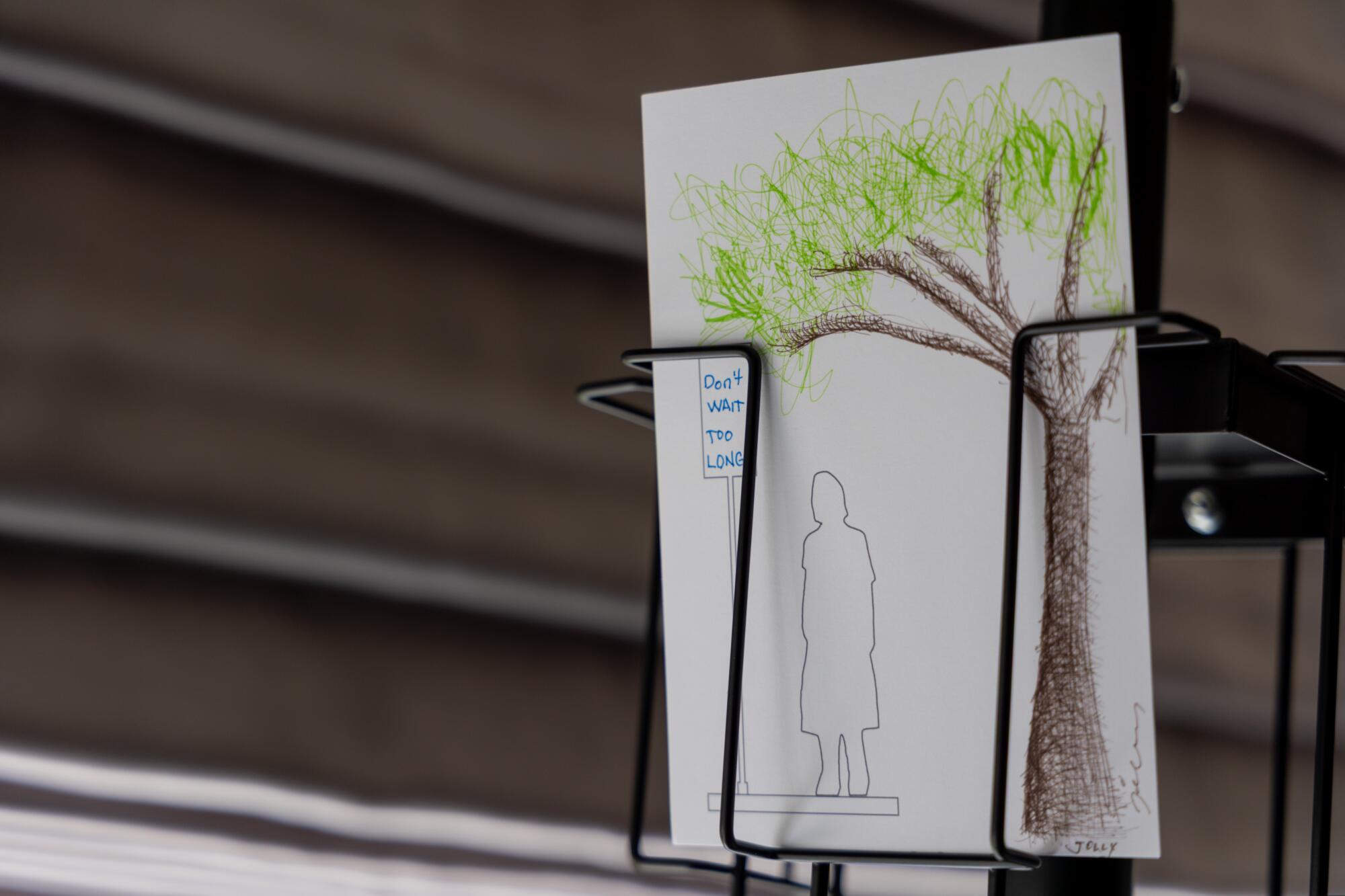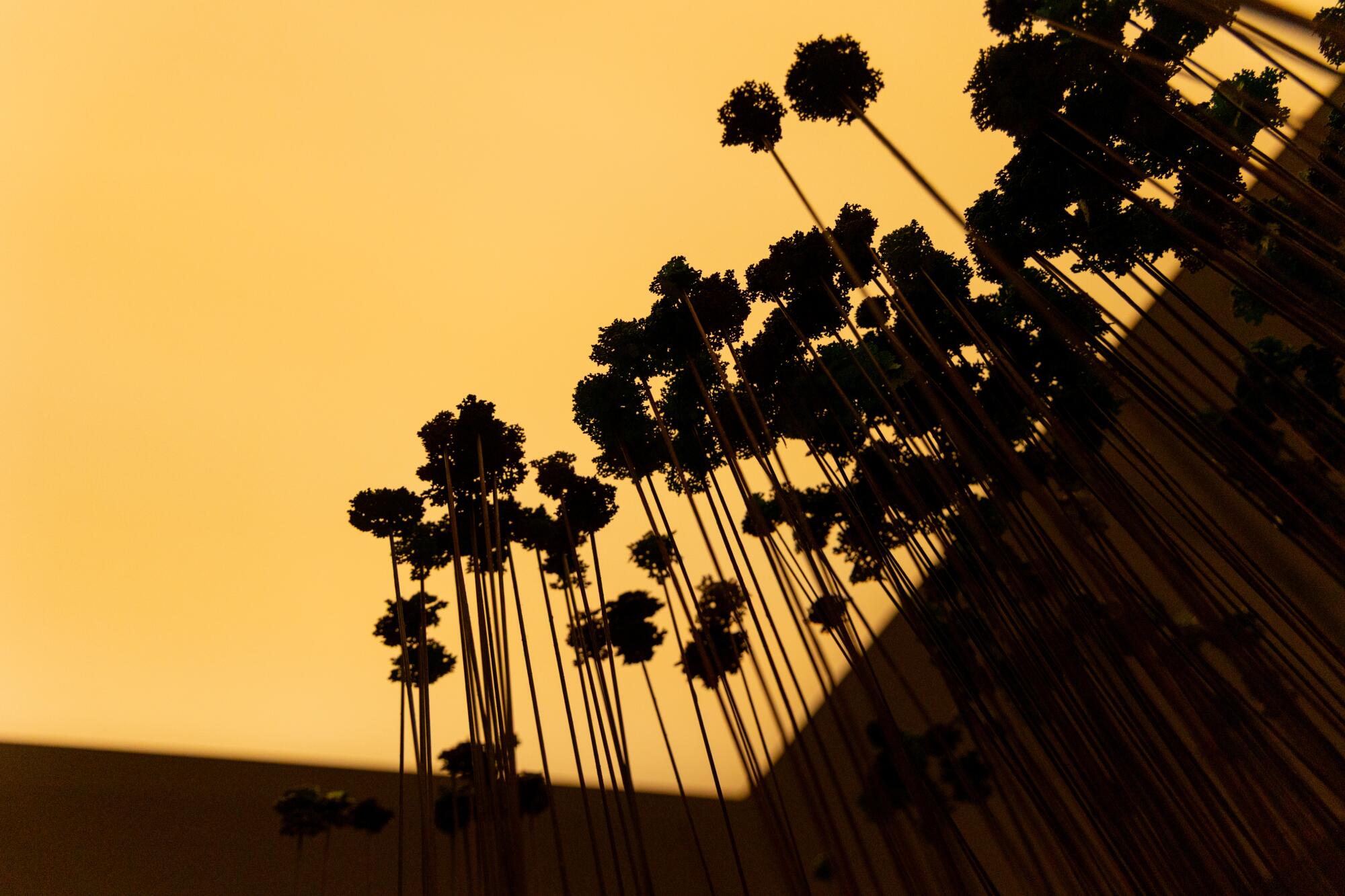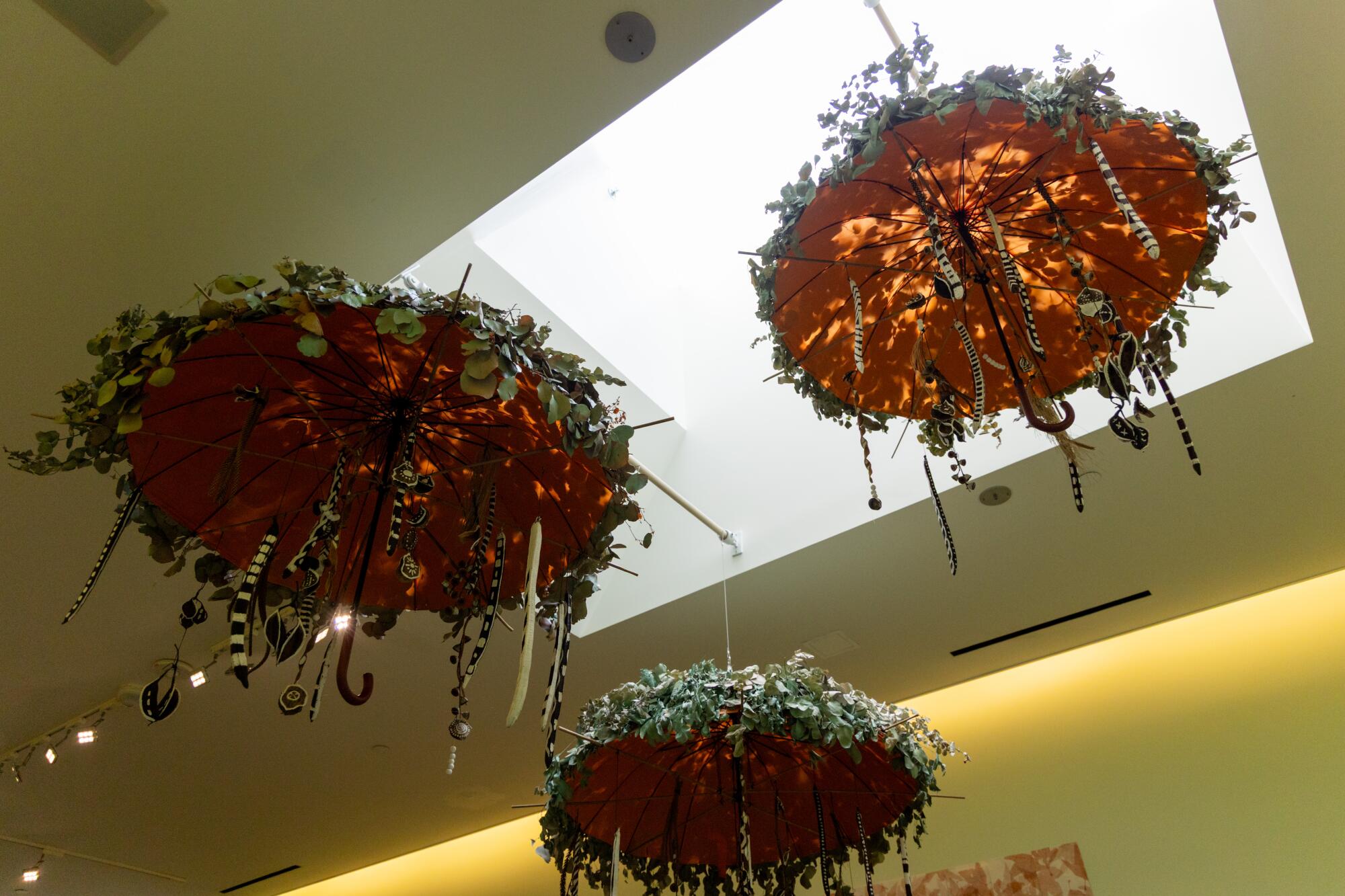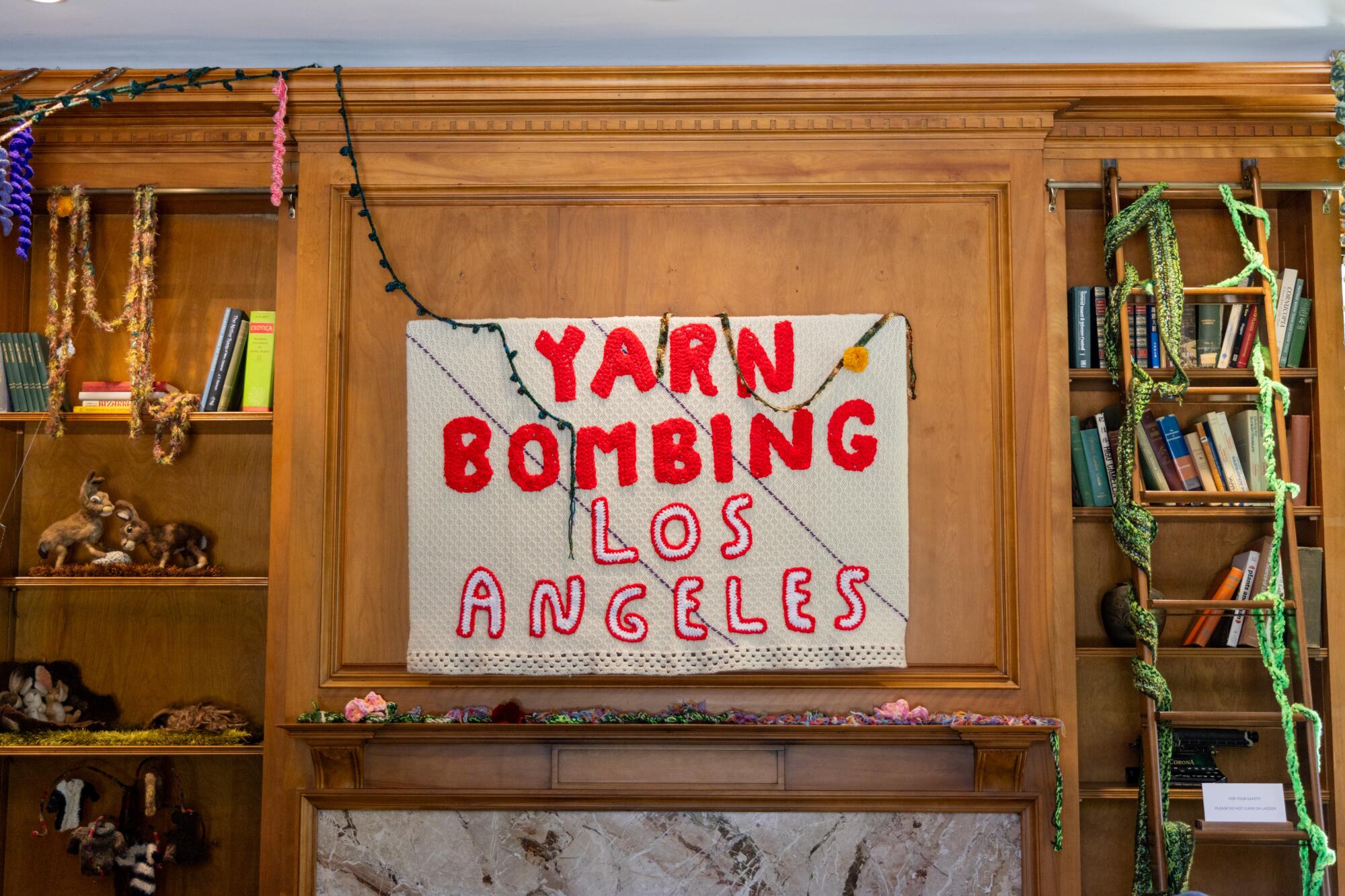This weekend, Descanso Gardens will unveil a meticulously curated art exhibition titled “Roots of Cool: A Celebration of Trees and Shade in a Warming World.” Co-curated by Edith de Guzman, cooperative extension climate researcher at the UCLA Luskin Center for Innovation, and artist Jolly de Guzman — a husband-and-wife duo — the exhibition highlights all-women artists who provoke visitors to contemplate the pressing issue of shade equity, the unequal access to cooling shade across urban neighborhoods, and what a tree and shade filled future can look like for L.A.
The goals of the exhibition are clear from the start, beginning with its title, “Roots of Cool,” which creatively integrates the Fahrenheit symbol in the word “of,” a tree in the letter “t” and the word “cool” as a shadow cast from the word “roots.”
The exhibit begins in the garden’s pathways, strewn with artworks, which lead visitors to the gallery rooms housed in the park’s Sturt Haaga Gallery and historic Boddy House.

A visitor’s proposal for a new type of bus stop that offers more shade, part of the new exhibition “Roots of Cool: A Celebration of Trees and Shade in a Warming World” at Descanso Gardens on July 9, 2025.
(Juliana Yamada / Los Angeles Times)
The first piece of art on the path, located at the gardens entrance, is Leslie K. Gray’s “Bus Stop of the Past,” an outdoor installation that shows the silhouette of a woman standing on an L.A. street, presumably waiting for a bus, with no shade structure nearby, meant to represent the climate-related challenges women bus riders faced while commuting in the past.
It’s the first of a three-part installation — the other two parts show up later in the exhibition — that invites visitors “to think temporally about where we’ve been and where we’re going,” Gray said. According to the artist, it is meant to highlight historical urban planning decisions that have left certain communities disproportionately vulnerable to heat, particularly women of color, who are prominent riders of L.A. public transportation, as indicated by statistics displayed on the bus signs accompanying the works.
Another standout of the outdoor part of the exhibition is Chantée Benefield’s “Cool Canopy,” which entails dozens of multicolored umbrellas suspended over visitors’ heads. The piece is particularly resonant given that it is actually a recreation that Benefield made after the original was lost, along with her family home, in the Eaton Fire.

Artist Chantée Benefield’s installation “Cool Canopy” at Descanso Gardens on July 9, 2025.
(Juliana Yamada / Los Angeles Times)
“What if the trees in neighborhoods were like graffiti, just ubiquitous everywhere?” Benefield asked. Her installation is both a colorful homage to lost greenery and a powerful statement on urban shade disparities, prompting visitors to contemplate what they would do without the shade being cast by these “trees” as they walk through the sunny patch where the work is located.
The next stop on the pathway is the second piece in Gray’s three-part installation: “Bus Stop of the Present.” It’s a version of the first, but with the addition of a shade structure for the woman bus rider. However, it shows clearly that the added structure is still inadequate, reflecting many of the realities women bus commuters face today. The bus sign here contains scientific facts that make the case for the critical need for systemic urban planning changes. Gray emphasized that these facts were carefully selected from peer-reviewed research and “scientifically vetted.”
Entering the Sturt Haaga Gallery, things change. Each room is meant to elicit a specific experience around urban planning and vegetation, and so each has its own visual and auditory scheme.

Kim Abeles’ piece “Looking for Paradise (Downtown Los Angeles).”
(Juliana Yamada / Los Angeles Times)
It begins with a dreary, urban past: shown against gray walls, works by Kim Abeles and Diana Kohne address historical inequities. Abeles’ installation “Looking for Paradise” visualizes the uneven distribution of trees in Downtown Los Angeles, while Kohne’s painted urban landscapes vividly depict the shade inadequacies she witnessed firsthand through her bus commutes as an L.A. resident, emphasizing how Los Angeles and other cities were built for “efficiency” rather than human comfort. The works are paired with compelling research, including the history of redlining and crucial heat-shade statistics, which visitors can interact with and see how their own communities are affected by these factors.
The next room is the present, with bright yellow walls representing the increasing urban heat of a changing climate. The artworks attempt to do the same. For example, Lisa Tomczeszyn’s installation, “Every Bench Deserves a Tree,” consists of two benches beside each other, one with no shade and only a street sign reading “Asphalt Blvd” while the other is shaded by a large tree — with leaves that are actually cutout photos of trees throughout the Deaconso gardens.
Finally, the third gallery room attempts to project a cooler, more verdant future with walls colored a serene green hue. It features works that imagine a future where technology and city planning better respond to environmental stressors, including Pascaline Doucin-Dahlke’s “Suspended Garden.” Like Tomczeszyn’s work in the previous room, this piece is also comprised primarily of benches set underneath umbrellas. In this case however, those umbrella canopies are made of repurposed plant materials.

Artist Pascaline Doucin-Dahlke’s piece “Suspended Garden” at Descanso Gardens.
(Juliana Yamada / Los Angeles Times)
One key goal of the exhibit is to help visitors connect to the importance of heat, shade and urban trees. For example, at the very end of the exhibit in the Boddy House, visitors can contribute to a real-world data collection study about how shade shapes their neighborhoods and what shade-heat related fact they find most striking, and are also invited to draw their imagined shade structures for women waiting at bus stops.
“[We] just don’t want to do science and just don’t want to do art. [We] want to create a good intersection that actually engages people,” said Jolly de Guzman.

Yarn Bombing Los Angeles’ installation inside of Boddy House at Descanso Gardens on July 9, 2025.
(Juliana Yamada / Los Angeles Times)
“We want to get them through the heartstrings, visually, aesthetically and actively,” added Edith de Guzman. Reflecting on the broader potential for change, she said, “There’s a lot of reasons to despair right now, but if we change our radio frequency a little bit, we can connect to a whole different feeling. We can actually create the city we want, in the neighborhoods that we deserve.”
The exhibition will run from July 12 to Oct. 12, 2025, with a free opening reception on Friday, July 11, from 5 to 7 p.m.


